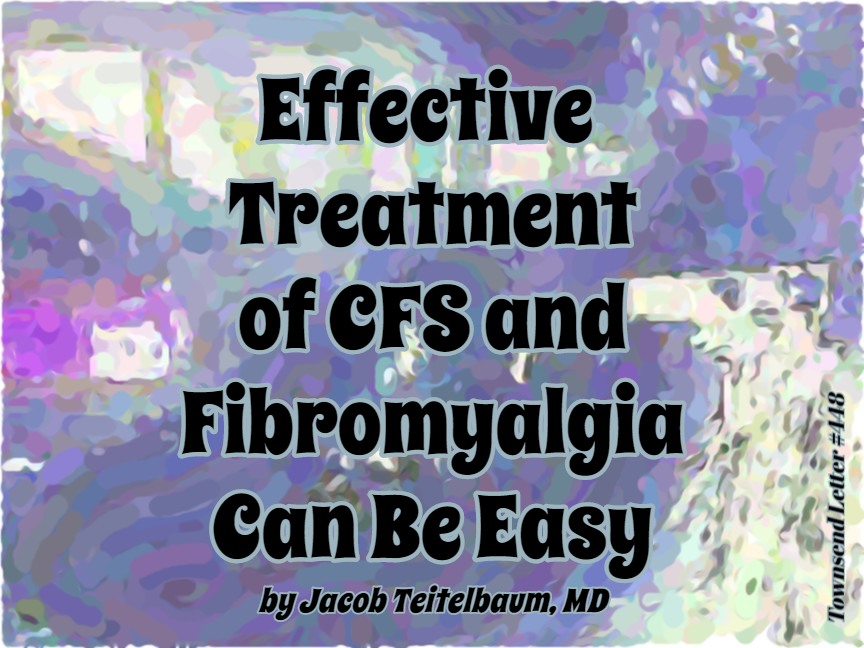by Leslie Axelrod, ND, L.Ac.
Fibromyalgia (FM) is a chronic pain syndrome that is multisystem and extends far beyond having tender points and muscular involvement. Multiple etiologies have been theorized including inflammatory, infectious, mitochondrial dysfunction, environmental, and genetic factors. It essentially affects all systems of the body, including but not limited to the neuroendocrine, neurotransmitter, immune, autonomic nervous systems, as well as at a cellular level.
Diagnosis has been challenging and the present criteria utilized focuses on subjective reporting of regions of pain, referred to as the widespread pain index. The most current 2016 criteria now include a symptom severity score, including fatigue, waking unrefreshed, and cognitive changes, which are all interrelated. These criteria do not include objective findings such as physical exam or laboratory findings.1 A study of almost 500 patients found that 11% of patients were diagnosed with FM and did not meet criteria, while 24% were not diagnosed with FM despite meeting present criteria. Women were more commonly misdiagnosed in favor of FM.2
Until recently, there have not been laboratory tests to confirm the diagnosis. The inflammatory markers ESR (erythrocyte sedimentation rate) and CRP (C-reactive protein) are commonly used to assess for other conditions that may mimic FM. The serum test FM/a, yet to be FDA approved, is starting to gain favor among some practitioners. It is covered by some insurance plans, including Medicare, according to the company EpiGenetics. The FM/a tests the WBC (white blood cell) chemokine and cytokine profile and gives a score of 1-100, with a positive at or above 50. The test is based on the cytokine response to mitogenic activation of plasma and peripheral blood mononuclear cells. Studies indicate cytokine response in samples tested in this way was significantly reduced in FM patients compared to healthy individuals, indicating an altered cell-mediated immunity unique to these patients.3,4 “The sensitivity, specificity, positive predictive and negative predictive value for having FM using this measure compared to controls was 93, 89, 92, and 91%, respectively,” as reported in a study of 477 patients, including rheumatoid arthritis, systemic lupus erythematosus, fibromyalgia patients, and 119 controls.4
Other diagnostic testing that was on the market for a period of time was based on research regarding investigation into microRNA (miRNA) profiles, small non-coding RNA molecules that translocate into mitochondria and act to downregulate gene expression and control cellular processes, among many other functions. Particular patterns of miRNA’s are being used as biomarkers for a variety of conditions. There are five particular miRNAs that are considered a “signature of FM” and have a high sensitivity and specificity for the condition.5 6,7 These miRNAs are varied in their function and appear to play an important role in the presentation of symptoms. For instance, one of the five miRNAs found, miR-143, contributes to neuropathic pain.8 Another miR-145 that was elevated in blood and cerebrospinal fluid of FM patients correlated with the pain and fatigue consistent with FM.5,9 Studies revealed abnormal levels of FM-related miRNAs affected sleep quality, pain threshold, and overall pain.6, 9 Continuing research on miRNA is being performed to assist in the diagnosis and ultimately treatment of an array of different medical conditions.
The cytokine and mitochondrial alterations present in FM patients influence the onset and course of the disease. Cytokines have been shown to communicate between the immune and nervous system. Cytokines become activated in infections and act to modulate or stimulate the immune system. In many cases, the symptoms of infection and fibromyalgia may resemble each other, with lethargy, myalgias and changes in social behavior. FM patients have elevated circulating cytokines, such IL-8, TNFa, and IL-10 compared to controls.10, 11 These cytokines can induce the symptom picture of FM: IL-8 promotes sympathetic pain, TNFa affects brain cell function, fatigue and anorexia.11 IL-10 appears to play an anti-inflammatory role.12
The role of infection has been investigated regarding an etiology of FM, particularly in those with acute onset. There have been a number of studies revealing elevated IgM or IgG levels, indicating a possible triggering event or concomitant infection. Associations have been made with Parvo19, HHV-6, HHV-7, H. pylori, EBV, as well as other infections for FM or FM-like syndromes.13,14,15,16 However, titers do not consistently correlate to the symptoms.13 A small study comparing viral antibodies in patients with acute onset FM revealed 50% of the patients had IgM antibodies against enterovirus compared to 15% of controls.17 Another study investigated the skeletal muscle of patients with chronic inflammatory muscle disease and FM, finding enterovirus viral RNA in 20% and 13% respectively, compared to none in the controls.18 Other studies showed higher frequency of persistent HHV-6, HHV-7 infection and H. pylori IgG antibody compared to controls.14,15 In addition to an infectious etiology, there are a multitude of other etiologies that may account for or contribute to abnormal cytokine profiles, including exposure to mold, environmental factors and autoimmune diseases, all of which might be considered when treating FM.19, 20 These pro-inflammatory cytokines, combined with oxidative stress and mitochondrial dysfunction, contribute to the symptom picture of hyperalgesia, fatigue, depression, and cognitive changes.4
Low dose naltrexone (LDN) is being used by clinicians with some promising results, possibly due to its effect on cytokines, as well as pain receptors. In a small single-blind crossover pilot trial, eight women were given low dose naltrexone, 4.5 mg, one hour before bed for eight weeks. The results found LDN statistically reduced plasma concentrations of multiple interleukins, including but not limited to IL-1B, IL1Ra, IL6, IL10, and TNFa compared to baseline. Concomitantly, a 15% reduction of FM-related pain and 18% overall symptoms were found.21 The limitations of the study included the small sample size, duration, and absence of a placebo or control group. Another pilot study, placebo-controlled single-blind, crossover with a washout period, revealed a reduction of symptoms compared to placebo by greater than 30%.22 Although erythrocyte sedimentation rate is not typically considered an indicator of FM, multiple studies found that patients with higher ESR’s had more severe symptoms. LDN was more effective in the high ESR groups with the greatest reduction of symptoms.21,22
In addition to addressing cytokine aberrations, therapeutic protocols directed at mitochondrial dysfunction have shown efficacy for FM. CoQ10 is involved in mitochondrial ATP production, regulation of oxidative stress, and cellular respiration. Deficiency has been associated with increased inflammation. Supplementation with CoQ10, 300 mg in divided dosages, was found to stimulate mitochondrial biogenesis and antioxidant activity, along with improving pain, number of tender points, and fatigue in FM patients.23 CoQ10 significantly reduced cytokines, including TNFa.24,25 Acetyl-L-Carnitine (ALC) assists in the transfer of acetyl groups into the mitochondrial inner membrane. The function of acetylated proteins in the mitochondria is to influence energy metabolism of the cell. A double-blind placebo-controlled study of 102 FM patients, taking 500 mg TID, resulted in statistically significant improvement in musculoskeletal pain, reduction of tender points and depression at 10 weeks, with improvement beginning at six weeks, compared to placebo.26 ALC was also found to modulate cytokine production in human peripheral mononuclear cells, particularly IL-6, IL1B, and TNFa.27 S-Adenosylmethionine, a methyl donor and precursor to glutathione, also decreases symptoms of FM, including tender point score, pain. and depression at a dose of 800 mg orally.28 It has also been found to decrease TNFa expression and increase IL10 an anti-inflammatory cytokine.29
There are multiple supplements that are utilized for FM, but one cannot discount the role of diet as well. There is an association between FM and higher BMI scores, which are relative to symptom severity.30 Obesity has been related to elevated TNFa in adipose tissue.31 A study in which mice with acid-saline injection-induced FM were fed a high fat diet “exhibited robustly increased levels of TNFa in plasma, muscles and spinal cord after acid saline injections compared with low fat-diet treated mice.” Hyperalgesia was significantly worsened after 24 weeks of the high fat diet. Mice lacking a specific TNFa receptor were resistant to the FM-like pain behavior when injections were given, indicating an association between TNFa activation and hyperalgesia.32 Other studies revealed a positive influence for dietary changes in FM patients. Findings from a food intake assessment study of women with FM revealed a high protein intake was related to improved pain threshold.33 A 2019 metanalysis of a variety of diets for FM stated raw vegetarian, low FODMAP, and hypocaloric diets showed promising results for symptom improvement and reduction of inflammatory markers. However, the authors’ assessment of the metanalysis was that overall the dietary intervention studies for FM are “scarce and low quality” and do “not allow conclusions to be drawn.”34
Article continues on next page…










